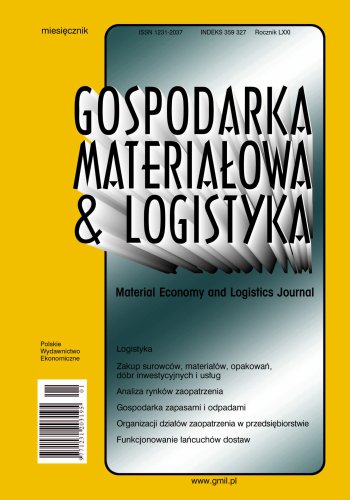Globalne łańcuchy dostaw w obliczu inwazji Rosji na Ukrainę oraz popandemicznej normalności
Pandemia zakłóciła tradycyjne łańcuchy dostaw i światowy handel głębiej niż inne kryzysy z niedawnej przeszłości. W złożonym środowisku biznesowym firmy zmuszone są przemyśleć i przeprojektować swoje łańcuchy dostaw pod kątem potrzebnej im odporności i elastyczności. Dlatego celem niniejszego artykułu jest identyfikacja trendów i rozwiązań logistycznych, które powinny zostać uwzględnione, aby firmy mogły umiejętnie poruszać się w nowej rzeczywistości. Na podstawie przeglądu literatury i doświadczeń przedsiębiorstw zostaną wskazane rola i znaczenie odporności (rezyliencji) oraz zarządzania ryzkiem w zapewnianiu sprawności i przejrzystości łańcuchów dostaw.
Bibliografia
Bibliografia/References
Balasa, A. P. (2020). COVID-19 on lockdown, social distancing and flattening the curve. A review. European Journal of Business and
Management Research, 5(3). https://doi.org/10.24018/ejbmr.2020.5.3.316
Blattman, C., & Miguel, E. (2010). Civil War. Journal of Economic Literature, 48(1), 3–57. https://chrisblattman.com/documents/research/2010.CivilWar.JEL.pdf (pobrano 25.05.2022).
Bloomberg. (2022). https://www.bloomberg.com (pobrano 06.07.2022).
Business Standard. (2020). COVID-19's Critical Disruption of Complex Supply Chains. https://www.business-standard.com/content/specials/new-coronavirus-outbreak-immediate-steps-for-multinationals-120032401104_1.html (pobrano 06.07.2022).
Chepeliev, M., Hertel, T., & van der Mensbrugghe, D. (2022). Cutting Russia's fossil fuel exports: Short-term pain for long-term gain. VoxEU.org, 9.03.2022. https://voxeu.org/article/cutting-russia-s-fossil-fuel-exports-short-term-pain-long-term-gain (pobrano 18.06.2022).
Christopher, M., & Holweg, M. (2011). Supply Chain 2.0: Managing supply chains in the era of turbulence. International Journal of Physical Distribution & Logistics Management, 41(1), 63–82. http://dx.doi.org/10.1108/09600031111101439
Deloitte. (2021). COVID-19 Managing supply chain risk and disruption, https://www2.deloitte.com/pl/pl/pages/risk/articles/covid-19-lancuch-dostaw.html (pobrano 7.07.2022).
GUS. (2022). https://stat.gov.pl (pobrano 28.06.2022).
Interos. (2022). Supply Chain Disruption from the Russian Invasion of Ukraine. Interos. https://www.interos.ai/wpcontent/uploads/2022/02/Interos_RussiaUkraineGlobalEcon_BP-3.pdf (pobrano 1.07.2022).
Kauf, S., & Tłuczak, A. (2015). Badania rynkowe w zarządzaniu łańcuchem dostaw. Difin.
Ketchen, D., & Craighead, C. (2020). Research at the intersection of entrepreneurship, supply chain management, and strategic management: Opportunities highlighted by COVID-19. Journal of Management, 46(8). https://doi.org/10.1177/0149206320945028 (pobrano 5.07.2022).
Korn, T., & Stemmler H. (2022). Russia's war against Ukraine might persistently shift global supply chains. VoxEU.org, 31.03.2022. https://voxeu.org/article/russias-war-against-ukraine-might-persistently-shift-global-supply-chains (pobrano 5.07.2022).
Kown, O., Constantinos, C., & Yotov, Y. (2022). Extraterritorial sanctions: A stick and a carrot. VoxEU.org, 4.03.2022. https://voxeu.org/article/extra territorial -sanctions-stick-and-carrot, (pobrano 29.06.2022).
McMaster, M., Nettleton, Ch., Tom, Ch., Xu, B., Cao, Ch., & Qiao, P. (2020). Risk management: Rethinking fashion supply chain management for multinational corporations in light of the COVID-19 outbreak. Journal of Risk and Financial Management. Special Issue „COVID-19's Risk Management and Its Impact on the Economy”, 13(8). https://doi.org/10.3390/jrfm13080173
Merz, M., Hiete, M., Comes, T., & Schultmann, F. (2013). Composite indicator model to assess natural disaster risks in industry on a spatial level. Journal of Risk Research, 16(9), 1077–1099. http://dx.doi.org/10.1080/13669877.2012.7 37820
Ngoc, N., Viet, D., Tien, N., Hiep, P., Anh, N., Troung, L. N., Anh, N., Trung, L., Dung, V., & Thao, L. (2022). Russia-Ukraine war and risks to global supply chains. International Journal of Mechanical Engineering, 7(6). https://www.researchgate.net/publication/361701652_Russia-Ukraine_war_and_risks_to_global_supply_chains (pobrano 4.05.2022).
Su, C., Dai, K., Ullah, S., & Andlib, Z. (2021). COVID-19 pandemic and unemployment dynamics in European economies. Economic Research — Ekonomska Istraživanja, 1–13. https://www.tandfonline.com/doi/full/10.1080/1331677X.2021.1912627 (pobrano 29.06.2022).
Taleb, N. N. (2014). Czarny łabędź. Jak nieprzewidywalne zdarzenia rządzą naszym życiem. Zysk i S-ka.
Teodoro, A., & Rodriguez, L. (2021). Textile and garment supply chains in times of COVID-19: Challenges for developing countries.
UNCTAD Transport and Trade Facilitation Newsletter N°86. 29.05.2021. https://unctad.org/en/pages/newsdeta,ils.aspx?OriginalVersionID=2380 (pobrano 28.12.2021).
Wieteska, G. (2018). The domino effect — disruptions in supply chains. LogForum, 14(4), 492–506. http://dx.doi.org/,10.17270/J.LOG.2018.302

